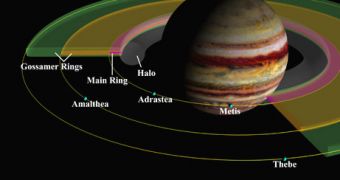New secrets of the giant gas planet have been exposed by NASA's New Horizons spacecraft during its recent flyby on the way towards the dwarf planet Pluto in 2015. New Horizons was sped on by Jupiter's gravity, saving years of its journey to the icy Pluto. This is the closest encounter with Jupiter since the Galileo mission, ended in September 2003.
The biggest surprise has been the lack of tiny moonlets within the planet's rings. 4 small moons are known to orbit Jupiter's large moon Io, the smallest being Adrastea, 12 mi (20 km) wide and Metis, 25 mi (40 km) wide. Earlier technologies weren't sensitive enough to detect smaller bodies, but researchers supposed that smaller moons existed.
"Looking for moonlets is important, because they are thought to be the source of the dust that forms Jupiter's faint rings," said Mark Showalter, a planetary scientist at the SETI Institute and lead author of the research on the "missing" moonlets. Such dust results when meteorites collide with small moons within the rings, spreading puffs of dust. Still, New Horizons can detect objects down to 0.6 mi (1 km) in diameter and found nothing.
"The most likely explanation is that meteorite bombardment has battered such small bodies to the point that they are too small for New Horizons to detect." said Showalter.
An unexpected discovery were the clumps of debris within the planet's main ring, which should have been quickly spread out by orbital forces.
"We haven't seen anything like this in any other planetary rings," said Showalter.
Surprises also came from three of Jupiter's bigger moons-Io, Europa and Ganymede.
Io is the most volcanically active structure in the solar system. During the flyby, Io's giant Tvashtar volcano was in the middle of a massive eruption (by May). The volcanic plume was over 215 mi (350 km) tall and 680 mi (1,100 km) wide.
Researchers believe that the plume's visible particles did not originate from the moon's core but are gases condensed by the frozen vacuum of space. The magma inside Ionian volcanoes seems to be hot enough to get an Earthlike basaltic rock structure.
A team led by Kurt Retherford of the Southwest Research Institute established what percentage of the Io's atmosphere is represented by volcanic gases.
"Io has a very tenuous atmosphere made up of sulfur dioxide." said Retherford.
Scientists had suggested that some of this gas could be spewed by the volcanoes, but that the rest derives from the evaporation of sulfur dioxide frost under the action of sun heat during daytime. This could be checked during the new flyby: during the night, 97 % of the atmosphere rapidly froze back.
On Europa and Ganymede, New Horizons' mission focused on mapping the "dirty" versus "clean" ice on the moons' surfaces and detecting the source of the "dirty" material.
Europa is suspected to harbor an ocean below its permanently frozen surface, and the "dirty" ice could be salt water welled up from beneath or contaminated with sulfur chemicals from the neighboring Io.
"Studying the ice might offer clues to whether the underlying ocean is suitable for life," said lead researcher William Grundy, a planetary scientist at the Lowell Observatory in Flagstaff, Arizona.
"The New Horizons instruments are sophisticated enough to tell what materials might be in the dirty ice, but at the time of the flyby the instruments hadn't been calibrated," added Grundy, who hopes that a complete calibration will provide better answers.

 14 DAY TRIAL //
14 DAY TRIAL //